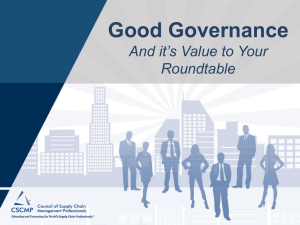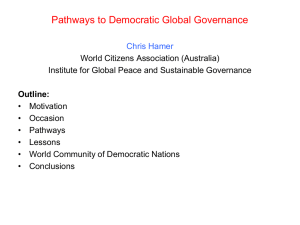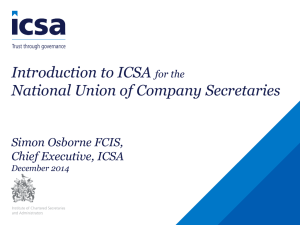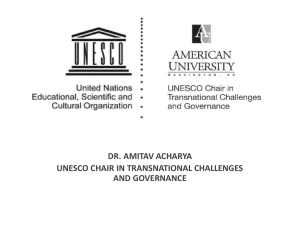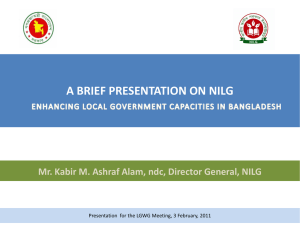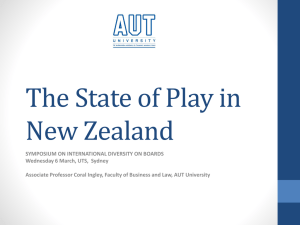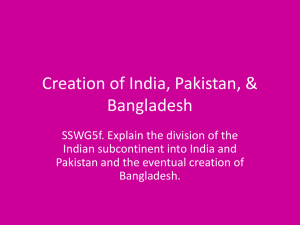Infusing South Asia Governance Challenges in - East
advertisement
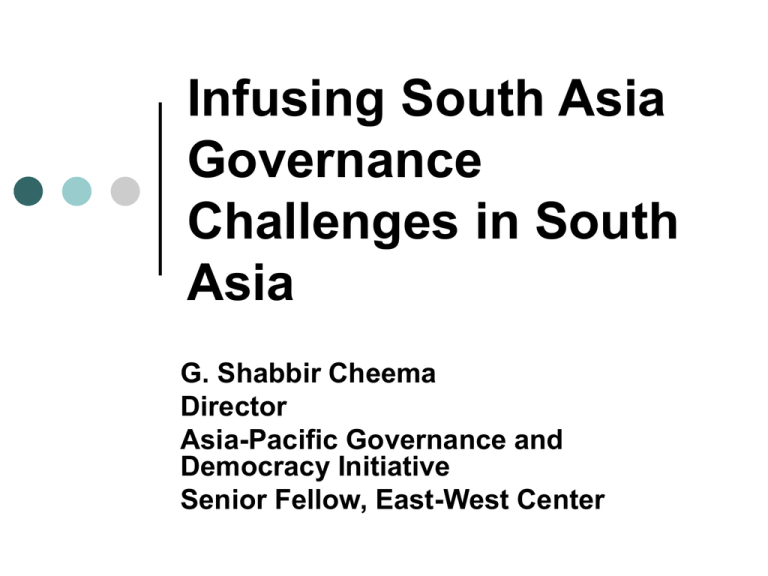
Infusing South Asia Governance Challenges in South Asia G. Shabbir Cheema Director Asia-Pacific Governance and Democracy Initiative Senior Fellow, East-West Center Part One: Introduction Over the past few decades, many transformations have taken place in South Asia. Three of those are relevant to our discussion today. Part One: Introduction First, effective "governance" is recognized as a necessary condition to combat poverty and lagging development including inadequate access to services, protection of the environment, and economic opportunities. Part One: Introduction Second, because of high incidence of poverty and exclusion of various groups, government are increasingly focusing on human development defined as enlarging people's choices, expanding their freedoms, and enhancing human capabilities. Part One: Introduction Human development as one of the big ideas presented and advocated by Noble Lauriette Amartya Sen from India and late Mahbub-ulHaq of Pakistan, both economists and class fellows at Cambridge In almost every country in South Asia, annual human development report where the question is asked "Governance for what". Part One: Introduction Third, all South Asian countries (other than Bhutan) today are electoral democracies, with varying degrees of sustainability of democratic institutions. Part One: Introduction These transformations are taking place in the context of globalization, with both positive and negative consequences increasing poverty and income equalities impact of trade liberalization on domestic industries inability of the private sector to absorb restructured public enterprises low capacity of governments to put in place social safety nets Part One: Introduction Two types of pressures for effective democratic governance To cope with demands of the global economy pressures from citizens for increased transparency and participation. Part Two : The Dual Reality South Asia is replete with examples of poor governance, which erode the capacity of communities and individuals— especially the poor and disadvantaged—to meet their basic human needs. an inefficient deployment of resources and crippling debt burdens and in some cases defense expenditures social divisions drawn on ethnic, sectarian and regional lines, as reflected in many intra-state conflicts Part Two : The Dual Reality (cont.) arbitrary law enforcement resulting from weakness of institutions in some cases failed political leadership uneven development and access to services and increasing income disparities - what poor governance means for ordinary citizens – schools without teachers, courts without justice, local bureaucrats demanding bribes at every turn.. Part Two : The Dual Reality Yet, some great examples of potential, as reflected in rapid economic growth and ICT revolution especially the emergence of India as the center of growth, entrepreneurships and innovation active civil society engagement in dealing with such issues as micro-finance and population growth such as in Bangladesh Greater participation of women in economic and political activities especially in Bangladesh, India and Sri Lanka Part Three - What are the key dimensions and challenges of governance in South Asia today? (1) The need to improve the quality of electoral and parliamentary process. What is the issue with regard to free, fair and regular elections? India, Pakistan, Bangladesh What is the issue with regard to the parliamentary process? Capacity, constituent relations, checks and balances Part Three - What are the key dimensions and challenges of governance in South Asia today? 2) To decentralize in order to improve local governance and citizen participation o Pakistan o India including the amendment to the Indian constitution which reserves seats for women o Nepal the issue still being debated o Sri Lanka the Tamil insurgency and its recent defeat Part Three - What are the key dimensions and challenges of governance in South Asia today? 3) High levels of corruption – two views about corruption in the literature The South Asian corruption has four characteristics: 1. upstream while making fundamental policy decisions; 2. South Asian corruption has wings i.e. smuggled out to safe heavens abroad; 3. weak process of accountability of senior politicians and officials the big fish unlike the US— 4. corruption in South Asia leads to mass deprivation in view of scarcity of resources unlike in the Western countries Part Three - What are the key dimensions and challenges of governance in South Asia today? 3) (cont.) Actions needed: accountability mechanisms, declaration of assets; transparent procurement procedures; right to information act; national anticorruption commissions; public education Some good examples – India's right to information Act; media's role in Pakistan to shame the politicians and senior officials about corrupt practices; PILDAT programs to pressure ministers and government officials to make their assets public Part Three - What are the key dimensions and challenges of governance in South Asia today? 4) Civil society engagement – evolution and growth; legal framework; accountability; capacity; impact on democratic governance Pakistan Lawyers movement; Civil society in India and Bangladesh in policy advocacy and access to services Part Three - What are the key dimensions and challenges of governance in South Asia today? 5) Capacity and accountability of civil service – the first level link between citizens and government for resource allocation, and service delivery and access Overblown responsibilities of civil service during the colonial and post colonial period Gaps between planning and policymaking and implementation Politicization of civil service leading to lack of impartiality and erosion of this institution Procedures for recruitment, promotion, transfers, training and other personnel policies Part Three - What are the key dimensions and challenges of governance in South Asia today? 5) Size Close to 50 civil servants for every 1000 people in Sri Lanka five fold increase in India from 1950 to early 1990s; increase in the number of ministries Impact of huge size of bureaucracy on inefficiencies but also high cost – In Pakistan, spending on civil service accounts for more than half of non-defense and noninterest expenditures with globalization and retrenchment of civil service ratio is being decreased but the role of civil service continues to be vital; changing roles of civil service in the global economy Part Three - What are the key dimensions and challenges of governance in South Asia today? 6) Judicial reform to ensure checks and balances Modern systems of civil and criminal justice have been in operation for over a century, but some issues Lack of effective access to justice for large segments of population; case load and long delays; erosion of judiciary in subordinate judiciary manned by inadequately trained judges and high level of corruption Part Three - What are the key dimensions and challenges of governance in South Asia today? 6) (cont.) Separation of powers between Executive and Judiciary – has been largely implemented in India but in Pakistan and Bangladesh Too many cases and too few judges: in Bangladesh, cases on average take from 5 to 20 years; Low pays, high cost and rampant corruption: A TI survey in India showed that 63 percent of the respondents had to bribe court officials in order to get a verdict in their favor. Poor do not have resources to pay bribes Part Three - What are the key dimensions and challenges of governance in South Asia today? 6) (cont.) Constraints on the independence of judiciary in the past – present situation an improvement – India, Pakistan Politicization of justice – engagement of political actors to influence the supreme judiciary ----- Part Three - What are the key dimensions and challenges of governance in South Asia today? 7) Economic dimension of governance in South Asia – South Asian countries are getting bigger without getting better Key problems hindering effective economic management: states are too big in unproductive areas and too small in essential areas Over-extended in production and trade creating inefficiencies and wasteful expenditures; till recently on economic controls; unable to actually enforce legislation such as that dealing with environment and human rights Part Three - What are the key dimensions and challenges of governance in South Asia today? 7) (cont.) They are fragile in performance in areas that are essential for any responsible state – such as social services delivery and access, redistributing resources such as land ownership, macroeconomic stability, coordinating government policies etc. Part Three - What are the key dimensions and challenges of governance in South Asia today? 8) Civil-military relations The need for professional armed forces and civilian control over the military as the cornerstones of democratic governance The interventions of military in Pakistan and Bangladesh over the years leading to the weakening of democratic institutions because of the break Reasons for military interventions in both countries Part Three - What are the key dimensions and challenges of governance in South Asia today? 8) Civil-military relations long term impact on the functioning of various institutions because of military's direct control on defense expenditure, involvement in economy, and in many cases continued weaknesses of democratic institutions Today in Pakistan – democratically elected government enjoys "entrance legitimacy" but is suffering from "performance legitimacy" and thus outsourcing key policymaking such as that deal with extremisms and terrorism to the military which continues to weaken democratic institutions. Summing up: Pockets of the entrepreneurship and innovation; yet, high incidence of poverty and low levels of human development Challenge to improve governance which is both democratic and effective – the need to build institutions by responding to the governance challenges

